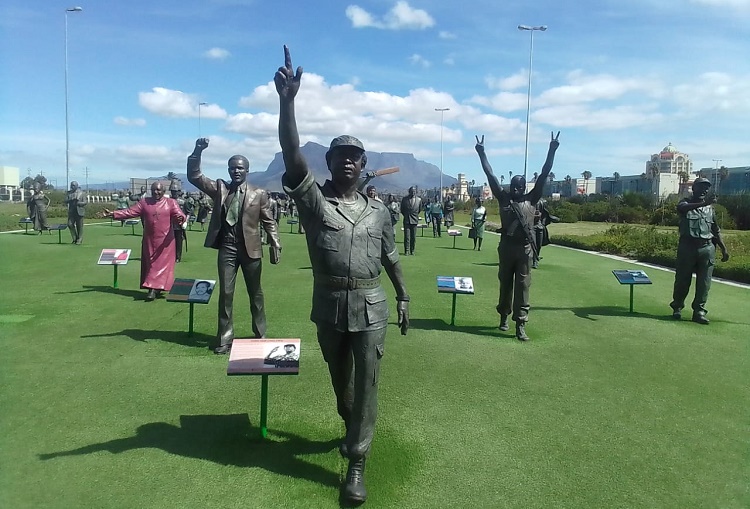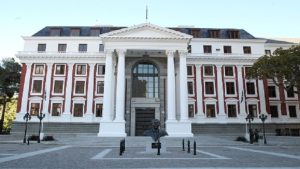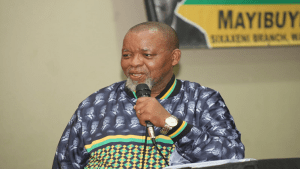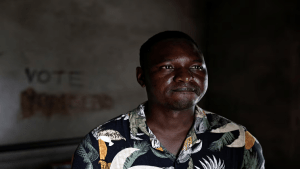As today marks 29 years since South Africa achieved freedom, the country has gone through different eras before achieving democracy in 1994.
The life-size bronze statues of the late heroes are displayed at the “Long March to Freedom” heritage site at Century City in Cape Town.
The artworks honour those who resisted colonialism and apartheid.
“Long March to Freedom” has over 100 pieces of artwork. They include icons and activists who resisted oppression starting with the first political prisoner on Robben Island, Harry die Strandloper.
Gallery below of activists: Pictures captured by Mercedes Besent on 29 March 2023
Walter Manganyi is a supervisor and Guide at “Long March to Freedom” and takes us through the various pieces of art.
“Harry die Strand Looper, he was called Autshumato. But the colonial masters decided to change his name and said we cannot call you Autshumato, we don’t know how to pronounce it. So, from today you are Harry die Strandloper. So, he became the first black prisoner in Robben Island. We also have one of the Khoi Khoi leader David Stuurman who went to Robben Island. But also, in Robben Island he didn’t stay also. He escaped three time, using a boat ride. So, when they caught him after escaping, they took him to Australian jail, is where he died.
Insert below by Mercedes Besent:
“Today as we speak, they changed PE airport named after him, David Stuurman Airport today. The first Nguni people to approach colonial masters. Here we have (Chief) Makana who went to Robben Island. And he was against missionaries since he was a prophet, a sangoma or a traditional healer. He escaped in Robben Island with David Stuurman there. So unfortunately, Makana he didn’t make it. He drowned in Blouberg Beach.”
The era of King Shaka Zulu during colonialism is displayed with various Zulu warriors who resisted oppression. Shaka is displayed holding a short spear, as Manganyi explains:
“His tribe they used a long spear to attack the enemy, so the man he decided to break it so that he can attack the enemy. Remember Shaka is the one who aligned all the tribes of the Zulu nation to become one.”
The then Union of South Africa, which was established in 1910, saw the beginning of the formal dispossession of land through the 1913 Natives Land Act, which came into effect on the 19th of June 1913.
“Awaking on Friday Morning June, 20, 1913, the South African Native found himself not actually a slave, but a pariah in the land of his birth”.
These were the words of Solomon Tshekiso Plaatjie after the 1913 Natives Land Act came into effect, almost 110 years ago. Sol Plaatjie, as he is known, was an author and a journalist, who used his bicycle as a mode of transport to travel across the country.
“Sol Plaatjie, he used to ride the bicycle from Eastern Cape to Joburg, carrying his typewriter at the back, so I mean when he got tired and get (a) chance , used his typewriter since he was a writer, a journalist, the first Secretary- General of the African Native Congress in 1912”, says Manganyi.
When the apartheid system kicked in, resistance continued with many activists across various political formations.
The founding father of the PAC, who led the 1960 Sharpeville March, Robert Mangaliso Sobukwe’s bronze statue, is displayed at the entrance of the “Long March to Freedom” site.
Some anti-Apartheid activists were jailed, while others were murdered. Black Consciousness leader, Steve Biko, died in detention on the 12th of September 1977.
Solomon Kalushi Mahlangu, an MK Soldier, was hanged by the apartheid regime on the 6th of April in 1979. SACP leader, Chris Hani, was assassinated outside his Boksburg home on the 10th April 1993.
The statues of the women of 1956, who led the march against the pass laws, are also on display. But, the fourth one, Sophie De Bruyn, is not on site as she is still alive.
“On my far right there we honour Lilian Ngoyi who was representing Black women, and she is carrying a petition. They were all carrying petitions there. In the middle is Helen Joseph who was representing Whites. I mean the third one is Rahima Moosa who represented Indians. The one who was representing Coloureds, she is still alive, it’s Sophie Williams-de Bruyn, since here we honour people who pass(ed) on, ” Manganyi explained.
The site also has a display of couples, who were activists. These include anti-apartheid activists, Grifiths Mxenge and his wife Victoria, who were both human rights lawyers. They were both assassinated by the apartheid security police hit squad in the early 1980s.
“Griffiths Mxenge, he was assassinated in 1981. And then when it comes to Victoria after the head of him, she didn’t live long. 1985 is where they decided to get rid of her as well. So, I mean it was very sad to South Africans,”Manganyi added.
Other couples, who also resisted the apartheid system, who are displayed in bronze, include Walter and Albertina Sisulu, as well as Oliver and Adelaide Tambo.
And who can forget the release of Nelson Mandela, accompanied by with his then-wife Winnie, On 11 February 1990, from the former Victor Vester Prison in Paarl, now known as Drakenstein Correctional Centre.
“These are a symbol where they captured him when he walked free from Victor Vester, together with Winnie.” As Manganyi
The most recent statue in bronze added to the big walking family is that of cleric, anti-apartheid activist and chairperson of the Truth and Reconciliation Commission, the late Archbishop Desmond Tutu.
During the recent unveiling of the Tutu statue, Dali Tambo, who is heading the National Heritage Project Non-Profit Company, said he was inspired to create the exhibition site after visiting his father’s grave.
“I said to him you know dad, there isn’t a single statue of you in South Africa and I’m planning to do one. And that evening, I got this message in my head from him, saying no Dali, don’t just honour him, honour all of them who served. And so, I sat along this journey. I recruited a lady called Sarah Haines, who is a great heritage expert.
And together we went forward. I went to Baleka Mbete, who encouraged me, she said go for it. I went to the National Lotteries Commission they encouraged me. I went to Pallo Jordan, I said would you be our historical expert. He agreed to do that and a few other professors from different universities. Because we wanted to ensure that although we could only do some, many to begin with, we wanted to make sure that they were worthy of being honoured of walking together as a collective, representing this sort of collective leadership that we have had over 350 years of generational struggle.”
The non-profit company still hopes to add more statues of activists who resisted 350 years of colonialism and apartheid.






